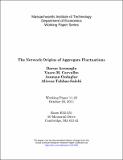| dc.contributor.author | Acemoglu, Daron | |
| dc.contributor.author | Carvalho, Vasco | |
| dc.contributor.author | Ozdaglar, Asuman | |
| dc.contributor.author | Tahbaz-Salehi, Alireza | |
| dc.date.accessioned | 2011-11-08T17:14:32Z | |
| dc.date.available | 2011-11-08T17:14:32Z | |
| dc.date.issued | 2011-10-20 | |
| dc.identifier.uri | http://hdl.handle.net/1721.1/66965 | |
| dc.description.abstract | This paper argues that in the presence of intersectoral input-output linkages, microeconomic idiosyncratic shocks may lead to aggregate fluctuations. In particular, it shows that, as the economy becomes more disaggregated, the rate at which aggregate volatility decays is determined by the structure of the network capturing such linkages. Our main results provide a characterization of this relationship in terms of the importance of different sectors as suppliers to their immediate customers as well as their role as indirect suppliers to chains of downstream sectors. Such higher-order interconnections capture the possibility of “cascade effects” whereby productivity shocks to a sector propagate not only to its immediate downstream customers, but also indirectly to the rest of the economy. Our results highlight that sizable aggregate volatility is obtained from sectoral idiosyncratic shocks only if there exists significant asymmetry in the roles that sectors play as suppliers to others, and that the “sparseness” of the input-output matrix is unrelated to the nature of aggregate fluctuations. | en_US |
| dc.description.sponsorship | This paper combines material from Carvalho’s Ph.D. dissertation at the University of Chicago (Carvalho, 2008) and Acemoglu, Ozdaglar, and Tahbaz-Salehi (2010). We thank the editor, Stephen Morris, and four anonymous referees for very helpful remarks and suggestions. We thank Stefana Stantcheva for excellent research assistance and Bill Kerr and Kaushik Ghosh for initial help with the NBER manufacturing productivity database. Carvalho thanks his advisor Lars Hansen and other members of his thesis committee, Robert Lucas and Timothy Conley. We are also grateful to John Fernald, Xavier Gabaix, Ali Jadbabaie, Alp Simsek, Hugo Sonnenschein, Jean Tirole, Jaume Ventura and numerous seminar and conference participants for useful feedback and suggestions. Carvalho acknowledges financial support from the Government of Catalonia (grant 2009SGR1157), the Spanish Ministry of Education and Science (grants Juan de la Cierva, JCI2009-04127, ECO2008-01665 and CSD2006-00016) and Barcelona GSE Research Network. Acemoglu, Ozdaglar and Tahbaz-Salehi acknowledge financial support from the Toulouse Network of Information Technology, National Science Foundation (Grant 0735956) and the Air Force Office of Scientific Research (Grant FA9550-09-1-0420). | en_US |
| dc.language.iso | en_US | en_US |
| dc.publisher | Cambridge, MA: Department of Economics, Massachusetts Institute of Technology | en_US |
| dc.relation.ispartofseries | Working Paper (Massachusetts Institute of Technology, Dept. of Economics);11-23 | |
| dc.rights | An error occurred on the license name. | en |
| dc.rights.uri | An error occurred getting the license - uri. | en |
| dc.subject | Business cycle | en_US |
| dc.subject | aggregate volatility | en_US |
| dc.subject | diversification | en_US |
| dc.subject | input-output linkages | en_US |
| dc.subject | intersectoral network | en_US |
| dc.subject | cascades | en_US |
| dc.title | The Network Origins of Aggregate Fluctuations | en_US |
| dc.type | Working Paper | en_US |
